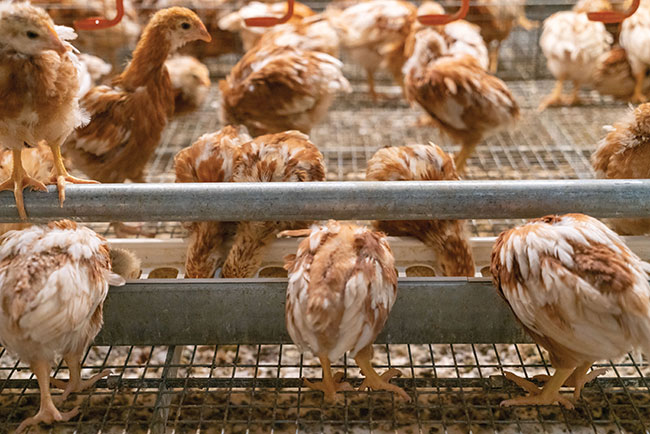
Mineral nutrition matters for bone (and egg) health
By Lisa McLean
Features Nutrition and FeedNew modelling project to help researchers bone up on bone health.
 The modelling project is intended to help understand how dietary calcium and phosphorus travel through the digestive tract, soft tissues, bone and eggs of both pullets and laying hens.
PHOTO CREDIT: Big Dutchman.
The modelling project is intended to help understand how dietary calcium and phosphorus travel through the digestive tract, soft tissues, bone and eggs of both pullets and laying hens.
PHOTO CREDIT: Big Dutchman. Phosphorus and calcium are essential minerals for bone – and egg – health, but exactly how they’re absorbed and used in the life cycle of a laying hen is not well understood. Now, a research team is examining how these minerals travel, with an eye toward improving hen welfare and environmental stability.
Marie-Pierre Létourneau-Montminy in Laval’s Animal Science Department has an international partnership with the French National Institute for Agriculture, Food and Environment (INRAe) to develop a model that will lead to an understanding of precisely how dietary calcium and phosphorus travel through the digestive tract, soft tissues, bone and eggs of both pullets and laying hens.
“Calcium and phosphorus are tightly linked,” Létourneau-Montminy says. “In general, the hen has to take some calcium from the bone to deposit it in the egg’s shell, and that process delivers phosphorus, which is then lost in manure. Inefficiency around phosphorus is one aspect we are trying to understand.”
She notes producers are facing more pressure to reduce their environmental impact and improve animal welfare. With better information about a hen’s mineral requirements at critical windows, industry may eventually be able to reduce phosphorus inputs and manure disposal costs and also reduce bone problems in hens.
Létourneau-Montminy’s team has completed similar modelling work on pigs and broiler chickens. She says the team’s initial plan was to apply the same approach to laying hens, but they soon realized the specific data their model required – such as information about digestion and how calcium is solubilized and bone growth in laying hens – is dated.
To get the information they need, her team will run two projects simultaneously. One will be a modelling project that will describe the fate of phosphorus and calcium in the digestive tract that will give them more accurate information about digestibility. In a parallel project, they will raise laying hens to 100 weeks with two different dietary phosphorus levels.
Researchers will test the hens’ bones for mineral content as well as body composition in fat and lean mass using a bone scanner tool used in human medicine. She hopes the project will give a better understanding of how bone evolves, and the amount of calcium that transfers to eggs as hens age.
Létourneau-Montminy says the researchers are also interested in determining the point in the cycle where the hens mobilize their bones to fulfill eggshell. The work is expected to be completed by 2023.
“We will generate the data and integrate it with our model to simulate protein growth, lipid growth, bone growth and the movement of calcium and phosphorus following egg development within the hen daily and weekly,” Létourneau-Montminy says. “A modelling approach allows us to adapt quickly with precision feeding and to predict daily requirements throughout a hen’s life cycle and will help us understand where more data and research are required.”
Létourneau-Montminy indicates the modelling approach will eventually provide important insights into nutrition requirements for hens at various stages, including current – and potentially extended – life cycles. She says the project also allows the opportunity for the Canadian research team to consolidate its ongoing work with important international partners.
This research was funded by the Canadian Poultry Research Council as part of the Poultry Science Cluster, which is supported by Agriculture and Agri-Food Canada (AAFC) as part of the Canadian Agricultural Partnership (CAP) program. Additional support was received from Egg Farmers of Canada, Royal DSM and Avimix Nutrition.
Print this page